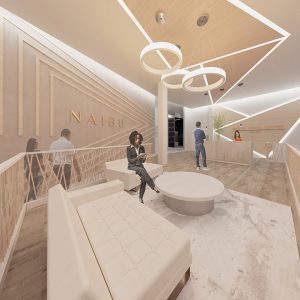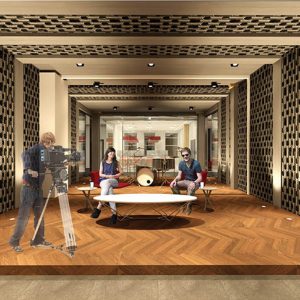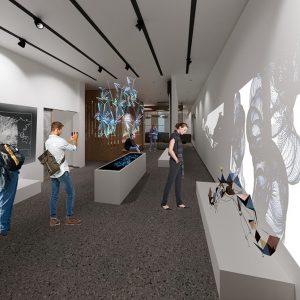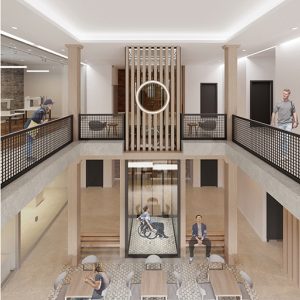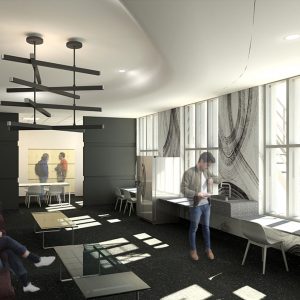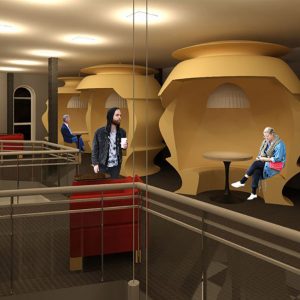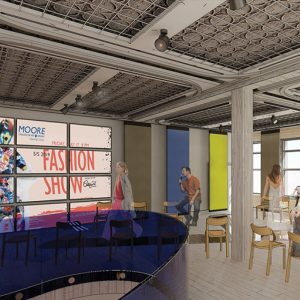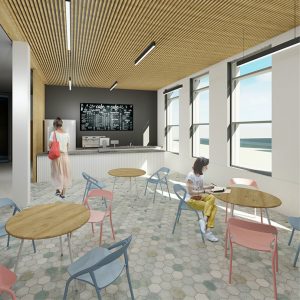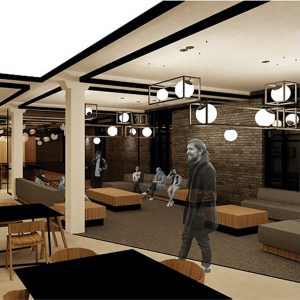
We are pleased to announce YEE-O 2020 – Year End Exhibition – Online edition for this 2019-2020 academic year. This annual event celebrates the hard work and creative achievements of over 500 undergraduate and graduate students from every unit and level in the Faculty of Architecture at the University of Manitoba. Unfortunately, COVID-19 led to the cancellation of this in-person event, but sharing and celebrating student achievements must go on!
ANALOGUE | DIGITAL: Media Arts Centre
Instructors: Jason Shields & Andrea Sosa-Fontaine
Typology:
A Media Arts Centre is a built environment designed for the exploration of analogue and digital-based art. This typology explores many facets of art, which can include education and preservation, handcrafting and analogue production, advanced digital creation, performance and rehearsal, exhibition, fabrication, and much more.
Studio Inquiries:
-What is the cultural significance of contemporary media arts centres?
-How does this typology continue to embrace hand-making and analogue art forms?
-How can we create a meaningful architectural response to the needs of the art community and the diverse demographic it encompasses?
-What architectural interventions can develop an inclusive design that also offers flexible, modular, and multi-function spaces?
-What role does lighting and materiality play in constructing a user-driven experience that responds to current and future needs?
Approach:
ANALOGUE | DIGITAL tasked 33 students with retrofitting a two/three-floor Media Arts Centre at the unoccupied 310 Ross Avenue building, located in Winnipeg’s Exchange District. Preliminary tours of 310 Ross and the Video Pool Media Arts Centre allowed the studio to gain a deeper understanding of the significance of media arts in the local context. Site visits, site analysis, precedent studies, and other investigations influenced the preliminary research. Concept ideation required students to develop a mixed media installation/object that intersected elements of both digital and analogue art. The resultant installation would serve as the conceptual inspiration for the design methodology. The programme, concept, and primary demographics vary based on the design concept of each student. Projects produced in the studio explore a multitude of ideas, with many focusing on the field of hand-making and others examining advanced technological environments.
Student concepts address a wide range of topics that include media preservation, community engagement, neurodiversity, social impact, and inclusivity.
Naibu
Lea Aballa
Internal is a place specifically for the visual and hearing-impaired individuals who are encourage to express their creative and artistic ideas and turn it into reality. The concept of surrealism is the inspiration behind the space planning and the interior design of the space. Surrealism art is the ability to dig into the unconscious mind in order to express individual’s full artistic potential. This said, the floor plan is designed to highlight the main function in each floor, similar to the surrealism, where there is always a main and central idea behind all artworks. The exhibition and studio are placed in the center since these spaces are meant to be used regularly where the artist can produce and showcase their works.
Connect
Anas Alkassim
CONNECT is located at 310 Ross Avenue at the exchange aims to support freelancers and provide a productive learning environment.The space concept is based on the required connection between each task and the flow of the work environment. The space for passionate professionals and small organizations in the media field oriented in journalism and training. The space aims to provide a learning environment allow new opportunities and connections. CONNECT allows the flow of information into a flexible and accessible form.
Users : Freelancers age of 18-32
– Small Medium organizations
– Non-profit organizations
– Journalists
– Influencers
Partners :
– Film Training Manitoba University of Manitoba (Film studies and Environmental Design program)
– Winnipeg Film Group
– Red River College
– Creative Manitoba
– New Media Manitoba (non-profit organization)
– Launch co-working space
MUSE
Guen Basilio
310 Ross is a Media Art Centre catered to emerging analog and digital artist. The space will provide facilities for workshops, exhibition, and collaborative workspaces. Focusing on the idea of biophilia as a means of creating a productive and inspiring atmosphere, the design of the space will incorporate natural elements and have a minimalistic approach through the use of lighter tones, encouraging fresh ideas. Ultimately, the space will provide opportunities for different artists to work together as well as engage with the community through expression of art and media.
Obscura Media Arts Center
Taylor Bishop
Obscura Media Arts Center aims through planning and materiality to create a strong connection between the public and media art with the intention to create a dialog between artist and the public, to allow for media art to become more understandable and accessible. This space specifically engages installation media artists, giving them a space to work on installation materiality and concepts, while engaging the public in the process work. This space allows for work in film/photo, audio recording and small-scale electronics work. This space is meant to be open to the public and encourage exploration, guiding the public to interact with those using the space.
Link
Shane Cuenca
Link will be a media arts centre that aims to foster connectivity, catered towards emerging adolescent artists ranging from age 12 to 22. A hub for collaboration and creativity, the space will aid in one’s transitional phase by helping to form one’s identity through the connections they will make and the centre’s explorative design. A mix of analog and digital amenities will allow artists to gain more knowledge from one another and reach a broader audience. To provide a comfortable and interactive environment, the space will also merge boundaries between educators, emerging artists, and professionals, allowing for opportunities of interaction to encourage discussion and dissemination of ideas. With this, amenities are placed close to public activities. The space will portray a raw yet refined aesthetic utilizing raw materials to symbolize one’s raw quality while searching for their identity.
SIZ3D
Gursimranjit Kaur
SIZ3D is located at 310 Ross Avenue in downtown Winnipeg. It is a Media Art Centre which exhibits Digital and 3D fashion. The centre allows the public, students, and artists to work on the second floor to fabricate 3D fashion using 3D technology. The first floor is designed for exhibitions, which also transforms into a retail space. The users of SIZ3D will vary due to the multiple stages of production; therefore, enabling users to practice their craft at a specific stage of production in creating a specific garment. SIZ3D is focused on the fabrication and production of materials used for creating garments. The design concept for SIZ3D is to provide an educational and production space for the fashion community.
Think Box
Bilal Khan
The Purpose of this Media Arts Center will be to provide a space for Engineers and Artists to Collaborate in a more direct and engaging manner. The rigid and Strict world of engineers Connecting with the free and fluid world of artists. The Juxtaposition of these two and the growth of media through technology. This new media center will allow to Bridge the Gap between the two mediums and will allow the Winnipeg’s community of technology and art to come under the same roof. It will work to end the Disconnection and will provide opportunities to Collaborate in a more meaningful way. This place will provide the unique mixture of two different yet similar fields of design. It will enhance and develop the community and Winnipeg’s arts and technology culture in the form of art installations, tech exhibitions, performance and collaboration from both sides.
I would like to focus on the growth and development of media. Technology, high tech robotics, developing styles and unique collaboration between technology and installation art is ever developing and keeps growing. This is why I would like to focus on this idea as it can be an interesting route that I can explore and design.
KEY WORDS: Disconnection – Connection – Juxtaposition – Collaboration – Growth – Mentorship – Bridging the Gap
TARGET DEMO: Students + Professional Artists/Engineers + Installation Artists + Emerging Artists
MEDIIUMS: Physical – (Visual): Robotics (High-tech) + Digital Media + Films + Graphics Sensory – (Audio): Audio Specialists + Sound Engineers
Habit.at
Josh Lingal
Habit.at is a media arts centre that addresses neurodiversity. Emphasizing the spectrum of cognitive functions among people, the facility introduces various workspaces that accommodate different levels of sociability, learning, attention, and mood. Spatial experiences—including visual, tactile, and auditory senses—are modulated through material selection, integration of an architectural language, and implementation of various furniture types. Additionally, the facility seeks to bridge both analog and digital art and integrates spaces that encourage interdisciplinary collaboration in a creative work environment.
Pixel Tech
Jeffrey Loek
Balter
Tiffany Maybituin
Balter means to dance artlessly or clumsily but with enjoyment. The Balter Media arts centre is a space dedicated for people suffering from mental illness such as depression and anxiety. It uses modern cultural dancing as a form of therapeutic expression enabling them to feel connected to everyone. The centre also provides spaces such as an audio, art and sewing studio’s that further supports the therapy as well.
The space will be designed in a flowing movement despite of its geometric shape, which guides the people around the circulation of the building. One of the main features of the building is the performance stage whereas the ramps is almost like embracing the centre. The purpose is to make people feel that they are part of the performance like how the building itself prioritizes the inclusivity of the people who are battling silently.
Motion Collective
Tristan Merke
The cultural significance of media arts comes from its universal accessibility to creative movements while allowing the observer to infer intention through personal interpretation. MOTION COLLECTIVE will serve as a space for the production and exhibition/observation of performative media arts.
This space will intend to provide current technologies for the production and innovation of art. MOTION COLLECTIVE will include gallery/screening/performance space. As well as a recording studio, acoustic controlled room, editing suites, performance rehearsal spaces and a photography darkroom. These spaces will make the performative media arts accessible to professional and amateur artists looking to take advantage of technology and convenience.
Methods Studio
Zach Morin
ZYZYGY
Barbara M’Pinda-Cimanga
SYZYGY is a media arts center bringing the world of fashion and technology together. Geared towards any designer who may not have the necessary equipment to create beyond their wildest dreams. The design concept comes from the galaxy. Outer space is something humans have always been fascinated about. Just like media arts it represents advancements in technology. Trying to solve the unknown mysteries of our world. Humans always dreamt of getting to the moon and they did through ideas, trials, and most importantly technology. The center is called SYZGY because it means the conjunction, yet opposition of planets and media arts is the conjunction of two very different areas of research, art and technology. Together creating amazing things.
310 Ross Ave
Brooke Nero
310 Ross Avenue is a heritage site now renovated into a media arts centre. The site originally manufactured clothing and now continues to support the creation of traditional art mediums. Workspaces accommodate the use of textiles, dyes, and paint, which then can be incorporated with digital media such as graphics, video/film, photography, projection mapping, and animation. The centre is designed to accommodate beginners through its variety of workspaces. Users may experiment with various media, learn from other attendees, and participate in planned workshops or classes.
Users enter directly into an open workspace. Guests are to feel welcomed and excited at the sight of active workshops. The central stair encourages exploration of the gallery or workshop above. Walls are formed semi-organically around the grid of columns and are softened by rounded corners. The primary colour palette is derived from the original colours used within 310 Ross Avenue, and when combined, covey an understanding of education.
Upskill
Sydney Shreiber
Upskill is a Media Arts Centre located at 310 Ross Avenue in Winnipeg MB. The Centre will focus on furthering the skills of children aged 8-12 in film and post-production. Media Arts bridges the gap between art and technology, giving a soul to something that is often seen as cold and technical. Upskill wishes to help bridge this gap by creating an engaging learning environment for children to gain skills in film and editing. Inspired by the De Stijl Movement, the space uses primary colours to liven up the rooms and create a playful rhythm throughout. Simple rectangular and square shapes and furniture will be used throughout to enforce this aesthetic, with some more organic forms being used to soften the space.
Introspection | Nooveau
Ulyana Statkevych
Introspection
Media arts connects people and art through an immersive experience and evokes a powerful sense of emotion which invites humans to an introspective analysis. Introspection is a process that allows people to examine their thoughts and emotions, understand their actions, notice a variety of patterns and analyze them. Most importantly, it provides a sense of purpose, which therefore leads to self-acceptance and happiness. Therefore, the goal of the installation was to create an immersive environment which would allow people to pause and reflect on their thoughts and emotions.
Nooveau
The images used for the projection were based on the Rorschach Test, which is a psychological test that consists of inkblot cards, used to understand people’s past and future behaviour, examine their personality characteristics and emotional functioning. The inkblot cards were created using watercolour paint, while the installation itself was made of acrylic and reflective film.
A Nooveau is a versatile space intended to welcome designers that refer to fashion as a form of art and self-expression. Featuring a captivating insight into the creative process of fashion making, Nooveau invites visitors to discover intricate detail and luxury designs, while initiating dialog between fashion, art, media, and public.
Media Arts Centre
Rebecca von Stackelberg
Apostasia is a Media Arts Centre located on 310 Ross Ave. The centre provides 3 studio spaces, editing & recording suites, and photography services. The first level studio offers a community and group work atmosphere, allows for development with people who are like minded in a work or casual setting. Allows for students to learn and interact with professional and semiprofessionals to learn from each other. The second and third level studios offers individual based space, also for reflection, development and freeness.This allows for users to explore their image and concept with their work that can be brought to a communal setting later if feedback and collaboration is needed to further their work. The common space, collaboration room, analog studio, kitchen and lounges allow for casual connections to be made amongst the users.
Also part of Analogue|Digital: Valerie Allen, Jose Rielle Aridru, Symrath Bali, Dominik Broughton, Yuanshan Chen, Tyler Davies, Mary Fahmy, Dela Ghasemi, David Gut, Laura Hiebert, Muntaha Khan, Christine Nguyen, Mia Papasotiriou, Roxanne Pelletier, Jihuan Sun, Zhao Yeo

